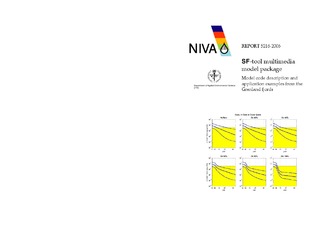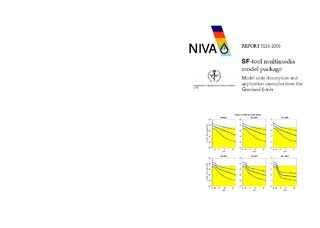| dc.contributor.author | Saloranta, T. | nb_NO |
| dc.contributor.author | Armitage, J. | nb_NO |
| dc.contributor.author | Næs, K. | nb_NO |
| dc.contributor.author | Cousins, I. | nb_NO |
| dc.contributor.author | Barton, D. | nb_NO |
| dc.contributor.other | Næs, K. - Project manager | nb_NO |
| dc.coverage.spatial | Telemark | nb_NO |
| dc.coverage.spatial | Grenlandsfjorden | nb_NO |
| dc.date.accessioned | 2014-08-01T10:50:27Z | |
| dc.date.available | 2014-08-01T10:50:27Z | |
| dc.date.issued | 2006 | nb_NO |
| dc.identifier | 5216 | nb_NO |
| dc.identifier.isbn | 82-577-4037-0 | nb_NO |
| dc.identifier.issn | 1894-7948 | nb_NO |
| dc.identifier.uri | http://hdl.handle.net/11250/213237 | |
| dc.description | Årsliste 2006 | nb_NO |
| dc.description.abstract | This report gives a description of an integrated multimedia modelling tool called SF-tool, and application examples from the modelling of the impact of planned contaminated sediment remedial alternatives on the future dioxin and furan levels of cod and crab in the Grenland fjords. The SF-tool (SedFlex-tool) consists of 1) a flexible water-sediment fugacity model code for simulating the sources, sinks and transports of persistent organic pollutants (POPs) in a fjord, estuary or lake system, and 2) a bioaccumulation rate constant model code for simulating the intake and bioaccumulation of POPs in a food web. In addition, the SF-tool contains tools for uncertainty and sensitivity analysis of the model results. The model simulations in the Grenland fjords show that a significant reduction in the concentration levels in cod and crab in the Frierfjorden can first be seen when larger areas of the Frierfjorden are capped, and thus significant portions of the contaminated feeding and habitat sediment areas of cod and crab are cleaned up. The same type of conclusion applies also in the outer fjords remediation scenarios. Furthermore, capping of contaminated sediments in the Frierfjorden will have no significant effect on the future evolution of the sediment concentrations (and hence on the concentrations in cod and crab) in the outer fjords or in the Langesundbukta. | nb_NO |
| dc.description.sponsorship | The Research Council of Norway | nb_NO |
| dc.publisher | Norsk institutt for vannforskning | nb_NO |
| dc.relation.ispartofseries | NIVA-rapport;5216 | nb_NO |
| dc.rights | Navngivelse-IkkeKommersiell-DelPåSammeVilkår 3.0 Norge | nb_NO |
| dc.rights.uri | http://creativecommons.org/licenses/by-nc-sa/3.0/no/ | nb_NO |
| dc.subject | miljøgifter - marint | nb_NO |
| dc.title | SF-tool multimedia model package: Model code description and application examples from the Grenland fjords | nb_NO |
| dc.type | Research report | nb_NO |
| dc.rights.holder | Norsk institutt for vannforskning/Norwegian institute for water research | nb_NO |
| dc.subject.nsi | VDP::Matematikk og naturvitenskap: 400 | nb_NO |
| dc.source.pagenumber | 44 | nb_NO |
| dc.subject.keyword | modellering | nb_NO |
| dc.subject.keyword | forurensede sedimenter | nb_NO |
| dc.subject.keyword | sf-tool | nb_NO |
| dc.subject.keyword | modelling | nb_NO |
| dc.subject.keyword | contaminated sediments | nb_NO |
| dc.subject.keyword | sf-tool | nb_NO |
| dc.relation.project | O-24018 | nb_NO |


